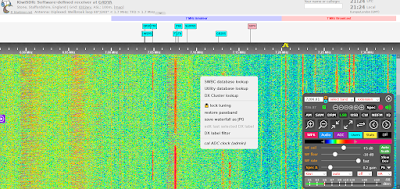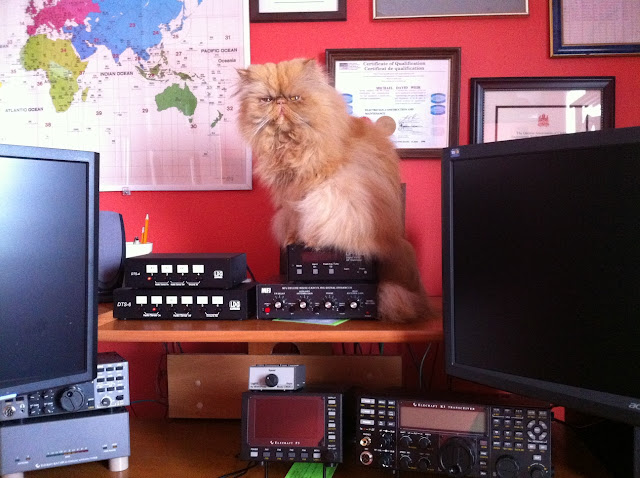 Armbian Linux for Arm processors and Android TV Boxes.
Armbian Linux for Arm processors and Android TV Boxes.
Steve, G1KQH, is a regular contributor to AmateurRadio.com and writes from England. Contact him at [email protected].
 Ham College 72
Ham College 72
Ham College episode 72 is now available for download.
Extra Class Exam Questions – Part 10.
E2D Operating methods: VHF and UHF digital modes and procedures, APRS, EME procedures, meteor scatter procedures.
1:00:28
George Thomas, W5JDX, is co-host of AmateurLogic.TV, an original amateur radio video program hosted by George Thomas (W5JDX), Tommy Martin (N5ZNO), Peter Berrett (VK3PB), and Emile Diodene (KE5QKR). Contact him at [email protected].
 Kiwi online SDR G4DYA
Kiwi online SDR G4DYA
The online G4DYA Kiwi SDR receiver is just 9 miles North of my QTH. Situated at Stone, Staffordshire. UK.
It has an excellent range of Amateur bands, and even goes down to LF 136KHz and 472KHz, it also has some good decoders built in to play around with for CW, PSK and even WSPR.
Ideal to test band conditions and your equipment.
Join in the fun here http://kiwisdr.lamont.me.uk:8073/
Steve, G1KQH, is a regular contributor to AmateurRadio.com and writes from England. Contact him at [email protected].
 Saying good-bye to my little buddy.
Saying good-bye to my little buddy.
Today we said good-bye to my best buddy of 15 years.....Oliver. Peace be with you, my little buddy you will be missed very much.
Mike Weir, VE9KK, is a regular contributor to AmateurRadio.com and writes from New Brunswick, Canada. Contact him at [email protected].
 North America Adventure Frequency: 146.58 MHz
North America Adventure Frequency: 146.58 MHz
 Recently, on the nasota group, there was a discussion about designating an alternative 2m FM frequency for Summits On The Air (SOTA) use (instead of 146.52 MHz). The main driver for this is that 146.52 MHz can get busy with other radio traffic and/or a busy SOTA activation can tie up the calling frequency for a long time.
Recently, on the nasota group, there was a discussion about designating an alternative 2m FM frequency for Summits On The Air (SOTA) use (instead of 146.52 MHz). The main driver for this is that 146.52 MHz can get busy with other radio traffic and/or a busy SOTA activation can tie up the calling frequency for a long time.
Rex KE6MT (SOTA W6 Association Manager) kicked it off with:
A friend of mine, George KJ6VU, has been talking with me and several others about the idea of an FM “Adventure Frequency.” It would be for more than just SOTA – other *OTA’s could also use it. There are other ideas to layer on top of it, such as tone signaling so that you don’t have to hear traffic you don’t want to hear, and repeater infrastructure for announcing someone’s on the frequency with a given tone, etc. But the core thing would be to decide on a frequency and really get it in use. The National Calling Frequency (146.52) can be great for a few contacts sometimes, but other times it’s problematic either because it’s being hogged or because nobody’s listening. Of course, this Adventure Frequency could have the same issues present themselves differently, but would alleviate some and pave the path for future additions mentioned above.
I have previously written about the challenges of using 146.52: The Use of 146.52 MHz
One important idea is to include the other “OTAs” in adopting this frequency, most notably Parks On The Air (POTA). Hence the name “Adventure Frequency,” and not “SOTA Frequency.” It is really about hams operating portable in an outdoor setting. Of course, like all amateur spectrum, this frequency must be shared with other users.
It may seem like a simple thing to choose a nationwide simplex frequency but VHF band plans are managed regionally. In particular, there is a mix of 15-kHz and 20-kHz channel spacings. (For more background on this see Simplex Channel Confusion on 2 Meters.)
After some discussion, the group settled on 146.58 MHz. There was some dialog around using CTCSS for signaling but nothing specific surfaced.
Some key points:
- The NAAF is 146.58 MHz.
- This frequency is in addition to, not a replacement for, the National Simplex Calling Frequency 146.52 MHz.
- Local usage will likely vary depending on needs.
- Program 146.58 MHz as The Other Simplex Frequency in your radio.
What does this mean to you?
Program 146.58 MHz into your radio and have it available. If you are doing SOTA (or POTA) activations, consider using this frequency, especially if you are in an area where 146.52 is used a lot. (I’ve already started using this frequency for SOTA activations near urban areas.)
73 Bob K0NR
The post North America Adventure Frequency: 146.58 MHz appeared first on The KØNR Radio Site.
Bob Witte, KØNR, is a regular contributor to AmateurRadio.com and writes from Colorado, USA. Contact him at [email protected].
 Linux Mint 20.1 Ulyssa Xfce released.
Linux Mint 20.1 Ulyssa Xfce released.
Latest version of Linux Mint released https://blog.linuxmint.com/
I am hopeful there will be a version for Arm processors soon?
Steve, G1KQH, is a regular contributor to AmateurRadio.com and writes from England. Contact him at [email protected].
 LHS Episode #385: The Weekender LXIII
LHS Episode #385: The Weekender LXIII
It's time once again for The Weekender. This is our bi-weekly departure into the world of amateur radio contests, open source conventions, special events, listener challenges, hedonism and just plain fun. Thanks for listening and, if you happen to get a chance, feel free to call us or e-mail and send us some feedback. Tell us how we're doing. We'd love to hear from you.
73 de The LHS Crew
Russ Woodman, K5TUX, co-hosts the Linux in the Ham Shack podcast which is available for download in both MP3 and OGG audio format. Contact him at [email protected].
















